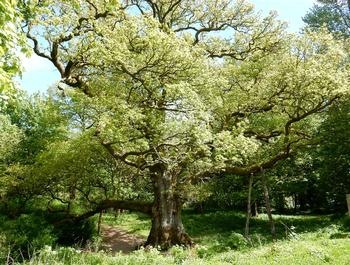
DURHAM, North Carolina, September 20, 2015 (ENS) – The relationships among living things, as they diverged from one another from the beginning of life on Earth more than 3.5 billion years ago, are shown for the first time in a comprehensive Tree of Life.
Tens of thousands of smaller trees of life have been published over the years for select branches of the tree, some containing more than 100,000 species, but this is the first time those results have been combined into a single tree that attempts to encompass all forms of life.

A collaborative effort among 11 institutions, the Tree of Life includes roughly 2.3 million named species of animals, plants, fungi and microbes – and it is far from complete, say the scientists who worked on the project.
The digital resource was published on Friday in the journal “Proceedings of the National Academy of Sciences.” It is now available free online for anyone to use or edit, something like a Wikipedia for evolutionary trees.
“This is the first real attempt to connect the dots and put it all together,” said principal investigator Karen Cranston of Duke University in Durham. “Think of it as Version 1.0.”
University of Michigan evolutionary biologist Stephen Smith heads the group that pieced together all the existing branches, stems and twigs of life’s tree into a single diagram.
Cody Hinchliff, formerly a postdoctoral researcher in Smith’s lab who is now at the University of Idaho, shares first-author credits with Smith on the PNAS paper.
“Many participants on the project contributed hundreds of hours tracking down and cleaning up thousands of trees from the literature, then selecting 484 of them that were used to generate the draft tree of life,” Hinchliff said.
Combining the 484 trees was a painstaking process that took three years to complete, said Smith, an assistant professor in the U. Mich. Department of Ecology and Evolutionary Biology.

Understanding how the millions of species on Earth are related to one another helps scientists discover new drugs, increase crop and livestock yields, and trace the origins and spread of infectious diseases such as HIV, Ebola and influenza.
“As important as showing what we do know about relationships, this first tree of life is also important in revealing what we don’t know,” said co-author Douglas Soltis of the University of Florida.
“Twenty five years ago, people said this goal of huge trees was impossible,” Soltis said. “The Open Tree of Life is an important starting point that other investigators can now refine and improve for decades to come.”
“This is just the beginning,” Smith said. “While the tree of life is interesting in its own right, our database of thousands of curated trees is an even more useful resource. We hope that this publication will encourage other researchers to contribute their own studies or to enter information from previously published sources.”
The current version of the tree – along with the underlying data and source code – is available to browse and download at: https://tree.opentreeoflife.org.
To help fill in the gaps, the team is developing software that will allow researchers to log on and update and revise the tree as new data come in for the millions of species still being named or discovered.
“It’s by no means finished,” Cranston said. “It’s critically important to share data for already-published and newly-published work if we want to improve the tree.”
“Twenty five years ago people said this goal of huge trees was impossible,” Soltis said. “The Open Tree of Life is an important starting point that other investigators can now refine and improve for decades to come.”

This research was supported by a three-year, $5.76 million grant from the U.S. National Science Foundation, including $900,000 to the University of Michigan.
Other study co-authors include: James Allman of Interrobang Corporation; Gordon Burleigh, Ruchi Chaudhary and Jiabin Deng of the University of Florida; Lyndon Coghill, Peter Midford and Richard Ree of the Field Museum of Natural History; Keith Crandall and Christopher Owen of George Washington University; Bryan Drew of the University of Nebraska-Kearney; Romina Gazis and David Hibbett of Clark University; Karl Gude of Michigan State University; Laura Katz and H. Dail Laughinghouse IV of Smith College; Emily Jane McTavish of the University of Kansas; Jonathan Rees of the National Evolutionary Synthesis Center and Tiffani Williams at Texas A&M University.
Copyright Environment News Service (ENS) 2015. All rights reserved.
